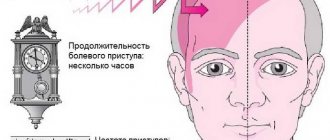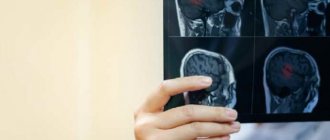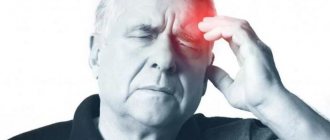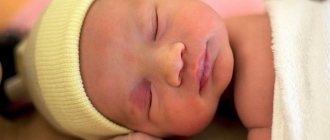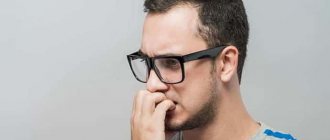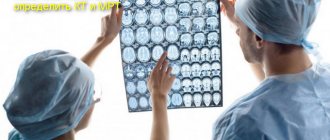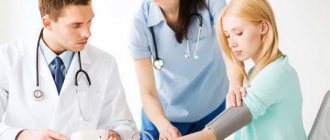It is known that the female half of humanity is more susceptible to migraines than the male half. Men are only 30% susceptible to this scourge, while the remaining 70% fall to the fair sex.
Moreover, this disease develops in young men, up to 40 years of age, and disappears when they reach 60 years of age.
And very often, experiencing attacks of pain over and over again, a person does not even think about the fact that it is actually a migraine. Most often, men simply consider it a regular headache.
Types and phases of migraine
There are 4 phases of hemicrania that accompany an attack:
- Prodorma - occurs about a day before the headache and is characterized by increased appetite, periodic mood swings, and frequent urination.
- Aura – represents sensory, visual, speech changes. Depending on the type of pathology, the aura lasts from 10 minutes to an hour, precedes an attack or appears at its height, or is completely absent.
- Headache - a person feels strong pulsations in one part of the head, as well as nausea, vomiting, and severe muscle weakness.
- Postdroma - the condition resembles a hangover and lasts about a day.
There are many types of migraine: with and without aura, cervical, ocular, cluster, etc. Let's look at the most common ones in men.
With an aura
Migraine with aura is also called classical. Aura is a symptom complex that signals the onset of an attack. When it occurs, a man may change his mood, feel irritability and fatigue.
The aura appears several hours before a headache attack and is considered one of the harbingers of pain. In its absence, a migraine attack develops suddenly and unexpectedly.
No aura
Hemicrania without aura or ordinary is the most common type. It is characterized by increased fatigue, fatigue, anxiety and depression.
If a man experiences a migraine without an aura, he feels severe, cramping pain for several hours, which is localized on one side of the head and interferes with life.
Painful sensations are accompanied by nausea, vomiting, and there is a fear of sounds and light, so the patient tries to hide in a dark and quiet place.
Cervical
Cervical hemicrania is one of the typical manifestations of vertebral artery syndrome. It is characterized by excruciating migraine-like pain, and occurs as a result of disruption of blood flow in the area of the right or left (or right and left) vertebral artery.
The causes of cervical migraine can be atherosclerosis, abnormalities in the structure and location of blood vessels, spasms of the neck muscles, spinal injuries, osteochondrosis, etc.
Basilar
Basilar (syncopal) migraine is rare, but it is very severe and is fraught with the development of various kinds of complications, including cerebrovascular accidents such as ischemic stroke. This is an aura disease that occurs predominantly in women. Among men, it affects young people of asthenic physique. The disease gets its name from the basilar artery, which supplies blood to the brain, cerebellum, and occiput. A severe headache is accompanied by damage to these structures.
Ocular view
Ocular hemicrania or ciliated scotoma is manifested by acute transient disturbances of visual functions. There is a distortion of vision (visual aura) or its complete disappearance.
The reason is improper blood circulation in the area of the visual centers and chiasma, which is neurological in nature. Often registered in teenage boys and middle-aged men.
Development mechanism
The mechanism of development of hemicrania is poorly understood to date. There are several theories, each of which has a right to exist:
- Wolf's vascular theory. Migraine is caused by a sudden narrowing of intracranial vessels, resulting in ischemia and aura. The blood vessels then dilate, causing severe headaches.
- Platelet theory. Under certain conditions, platelets are susceptible to sticking together, which leads to significant release of serotonin and constriction of blood vessels in the brain. At the same time, the synthesis of histamine (the hormone responsible for the functioning of vital organs) increases; it lowers the pain threshold of the artery walls. Then the production of histamine and serotonin is reduced, the vessels dilate, their tone decreases, and tissue swelling occurs.
- The theory of spreading depression. According to it, a wave of decreased nervous activity passes through the brain, causing chemical and vascular disorders. This leads first to a narrowing of the blood vessels, and then to their expansion.
- Combined neurovascular theory. Believes that the disease is caused by a disruption of the normal relationship between the trigeminal nerve and the blood vessels of the brain. Under the influence of provoking factors, the trigeminal nerve is activated, and its endings secrete vasodilators. Vascular tone worsens, permeability increases.
Neck option
The disease is similar in nature to the development of basilar migraine, but is caused by problems in the vertebral artery. Defects in the blood supply to the areas that are functionally attached to it occur as a result of its spasm under the influence of certain factors.
In this case, the muscles of the back of the head, neck, as well as the oculomotor muscles on the affected side are especially affected. The pain often seems to radiate to the temple and to the space behind the eyeball.
The shoulder on the affected side and even the upper limb are not spared from pain.
Symptoms and signs in men
Male migraine occurs differently than female migraine. Attacks occur less frequently in men, but the pain is more intense and lasts a long time.
When migraine symptoms appear, a man feels depressed, tired, and there is a decrease in concentration. In some cases, memory lapses occur.
The main signs of migraine in men:
- nausea, vomiting;
- loss of performance;
- increased body temperature, attacks of fever;
- localization of pain in certain areas of the head.
Depending on the type of pathology, other symptoms appear.
A migraine attack can last from several hours to several days. After the attack ends, the man feels broken and empty for about a day.
In severe cases, the disease leads to prolonged depression and weakened immunity.
How to relieve an attack yourself at home
Let's look at what to do when a migraine strikes unexpectedly. The male form requires the following actions:
- first you need to put aside panic, calm down and lie down;
- good ventilation of the room will ensure the flow of oxygen, so you need to open the windows wide open;
- it is necessary to turn off the lights and eliminate sound stimuli, for example, turn off the TV;
- if the attack is not happening for the first time and there is already a doctor’s prescription, you need to take medicine;
- It is better to loosen tight clothing, for example, unbutton the buttons on a shirt;
- when chills appear, you need to cover yourself with a warm blanket;
- A glass of water at room temperature or a cup of green tea will help you come to your senses.
In any case, the patient will need to sleep. Rest will benefit the body, and a male migraine attack will subside. It should be remembered that when your condition improves and your symptoms alleviate, you should not immediately rush into everyday activities. You need to spend some time in peace.
The main causes of the onset and exacerbation of the disease
An attack develops under the influence of provoking factors – migraine triggers. They are internal and external.
Physiological
- bright light;
- noise, loud sounds, music;
- strong, pungent odor;
- flickering light.
Food
- flavor enhancers used in canned food and seasonings;
- sweeteners included in carbonated drinks, chewing gum, juices;
- sodium nitrates – used in canned meat;
- tyramine – found in hot smoked fish, blue cheeses, alcohol, yeast, salted herring;
- Tea coffee;
- chocolate, legumes, nuts, citrus fruits;
- fat-containing products;
- smoked and pickled products;
- seafood.
Neuropsychiatric
Factors that cause the release of adrenaline accompanying hemicrania:
- acute and chronic stress;
- lack of sleep or sleeping too much;
- overwork, fatigue;
- abuse of diets, unbalanced, irregular nutrition;
- change of time zones, change in the rhythm of life;
- increased physical activity without proper preparation.
Smoking
Smoking causes a sharp narrowing and then dilatation of blood vessels. This leads to a lack of oxygen and triggers migraines.
Environment
- changes in atmospheric pressure and weather conditions;
- increase or decrease in air temperature;
- strong odors of household chemicals, paints and varnishes, tobacco smoke.
Head and neck injuries
Trauma or injury, concussion, or damage to the brain do not go away without leaving a trace. In traumatized people, migraines become a frequent companion.
Prevention
To prevent migraine from developing, it is necessary to identify and eliminate provoking factors. Patients are recommended:
- Adhere to a healthy lifestyle.
- Eat right (exclude foods with preservatives and nitrates from your diet).
- Avoid overexertion, conflicts and stress.
- Give your body daily physical activity and proper rest.
- Minimize alcohol consumption.
- Drink more fluids.
- Strengthen immunity, harden.
Whatever methods of migraine treatment the doctor chooses, you need to listen to his recommendations: take prescribed medications in a timely manner, and do not refuse additional examinations. It is better to cure an incipient disease in time than to suffer from its serious consequences later.
How to distinguish it from a headache?
You can distinguish a migraine from a headache of another nature by the following signs:
- The headache is localized on one side of the head. Sensations are concentrated at the temple and radiate to the eye;
- the nature of the pain is squeezing and throbbing;
- characterized by weakness in the body and sensitivity to bright lights and sounds. If you endure an attack lying down in a dark room and silence, the pain subsides;
- with physical activity, walking and running, the pain intensifies;
- migraine lasts 2 hours – 3 days;
- Nausea and vomiting are not always present, but quite often.
Treatment
There is no need to self-medicate at home.
After the examination, it is the doctor who will prescribe the necessary medications to help cope with the disease.
When an attack is recorded, the patient should be isolated from irritating factors.
How to treat an attack?
Treatment of migraine involves the use of medications and reflexogenic methods.
They can be taken when the patient recognizes the aura or when severe symptoms are present. In particular, the following means are used:
- ibuprofen;
- nasal sprays;
- triptans;
- aspirin.
What else helps with migraines? From time to time reflexive methods are used in the form of:
- acupressure of the face and head;
- acupuncture;
- contrast procedures (cold and warm).
How to treat migraine in men?
What is the treatment for periodic headaches in men? Experts use the following methods:
- drug therapy;
- gentle diet;
- physiotherapy;
- physiotherapy;
- acupuncture;
- recommendations to the patient regarding the normalization of work and rest schedules. For relapses of the disease, treatment at home, on your own, is suitable.
Folk remedies
Migraines can be treated at home if you know what triggers the attacks and if the headaches are tolerable. In this case:
- An infusion of oregano helps. Pour boiling water over the dry herb in a ratio of 1 tbsp. l. to 300 ml, leave for an hour. Strain and drink instead of tea 3 times a day.
- Place a fresh lemon peel on the sore side of your temple, removing the zest. This will have a distracting effect.
- Use essential oils such as lemon balm and peppermint. Rub them into the area of your temples or ears, 1 drop at a time.
Drug therapy
Aimed at relieving migraines and preventing them in the future. Most often, doctors recommend taking the following medications:
| Name | Recipe |
| Imigran | Stops an attack half an hour after taking it. Take 1-2 tablets. |
| Zomig | Take 1 tablet during an aura. It works within a quarter of an hour. |
| Relpax | Take 1 tablet. The effect is achieved within 30 minutes. |
For mild to moderate attacks, the following may help:
- conventional and combined painkillers: Paracetamol, Aspirin, Citramon, Analgin;
- NSAIDs – Diclofenac, Ibuprofen;
- ergotamines (contain ergot alkaloids) – Migranal.
Triptans
Triptans are the drugs of choice for migraine treatment and are designed specifically to relieve migraine headaches. An important condition is that they must be taken at the beginning of an attack, otherwise they may be ineffective.
Popular representatives of triptans are:
- Amigrenin;
- Sumamigren;
- Rapidmed;
- Zolmitriptan;
- Eletriptan;
- Naratriptan.
Opioid drugs
Used to relieve high intensity migraines. These drugs contain codeine, tramadol, meperdine, and hydrocodone. Prescribed only by doctors.
Treatment with opiates is only suitable for very short, occasional use, as they cause dependence and tolerance (addiction).
Corticosteroids
This group includes Dexamethasone and Prednisolone. Helps relieve severe and persistent migraine attacks.
Use for no more than a week, as complications such as osteoporosis or Itsenko-Cushing syndrome are possible.
Ways to fight at home
You can combat attacks of hemicrania together with medications using physiotherapeutic methods that can be easily implemented at home:
- cold compress on the forehead or back of the head;
- a hot bath or heating pad applied to your feet;
- light head and neck massage;
- auto-training, acupuncture;
- rest and short sleep.
In addition to treatment, dosed physical activity and walks in the fresh air help combat migraines. They develop endurance and train the circulatory system.
Diagnostics
The diagnostic procedure involves:
- Examination by a neurologist to determine the duration of the onset of the disorder and its possible cause.
- Blood, urine, feces are submitted for analysis. Test results indicate an infection in the body.
- MRI examination. The pictures show the characteristics of the body and possible deviations from the norm leading to the disease.
Possible consequences of neglecting headaches
Migraine pain should not be ignored, as it can lead to serious consequences.
Chronic migraine
A diagnosis of chronic migraine is made if a patient experiences headaches lasting 15 days or more per month. The following factors are responsible for the development of episodic pain into chronic pain:
- uncontrolled use of painkillers or lack of treatment;
- prolonged depression;
- decreased quality of life.
Stroke
Migraine is one of the top three causes of acute circulatory disorders in the brain. So, sometimes the immediate consequence of a migraine attack is an ischemic stroke or cerebral infarction.
Patients with existing atherosclerotic lesions are especially prone to getting sick.
Migrainous status
Migraine status is characterized by intense and prolonged attacks, accompanied by:
- severe headache;
- nausea, vomiting;
- fear of bright light;
- temporary visual impairment;
- increased irritability.
The headache lasts constantly and does not go away even after sleep.
Complicated forms
If migraines tend not to stop for more than three days, then it makes sense to talk about migraine status. Its main features can be considered:
- vomiting that continues uncontrollably and does not have a relieving effect on the body;
- weakness, passive behavior, bad mood;
- fainting states
- preconvulsive muscle movements, then convulsions;
- decreased vision and others.
Another form of complicated migraine is migraine infarction - the appearance of special lesions that often tend to compensate.
